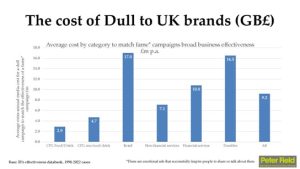What advertising messages do you remember seeing today? And of those, which really stood out? Hmm… yeah, we thought so.. little to none! Consumers today are bombarded with countless marketing messages every day from various sources like TV, social media, outdoor ads, and more. Out of the 5,000+ messages encountered, we only truly recall a handful, as we instinctively filter out most through selective retention.
Unless our marketing delivers something different, creative, or provocative, there’s a high risk of going unnoticed, leading to financial implications. Let’s explore the risks of being ‘dull’ and the power of creative bravery in marketing.
What we cover
1. The Prevalence of ‘Dull’ Marketing
2. The Financial Costs of Blandvertising
3. Creative Bravery – ending the dull
4. What FS Marketers can do to ‘ban the bland’?
5. Final thoughts
1. The prevalence of ‘dull’ in marketing campaigns
Recent research by marketing consultants Morgan & Field on the human response to 100,000 different adverts found that 48% of ads are so dull they do not register any emotions and are likely to prove ineffective. Most people these days find ads so ineffectual that they are now actively skipping them, paying a premium to avoid them – adverts are in negative equity! Dull ads shut people out. They turn people off. They disconnect the viewer. And for marketers, there is a real financial cost to being dull.
2. The financial costs of ‘blandvertising’
Morgan and Field’s 2023 research identified the financial cost of mediocre communications – showing that ads deemed boring are 6.1 times more ineffective at growing market share than interesting ones. Their research showed that the financial services industry in particular had to spend £10.8m per year in media just to match the effectiveness of so called ‘fame’ ads (emotional ads that successfully inspire people to share or talk about them). Showing you have to work so much harder to land a dull message than an interesting one. Fields cites the impact of 15+ years of performance marketing as a reason why advertising is getting increasingly dull. Years of focus on results marketing has driven short-term, bottom-of-funnel sales which has also spilled over to top of funnel cost-reduction thinking where creativity is a second-thought.
Fields cites the impact of 15+ years of performance marketing as a reason why advertising is getting increasingly dull. Years of focus on results marketing has driven short-term, bottom-of-funnel sales which has also spilled over to top of funnel cost-reduction thinking where creativity is a second-thought.
3. Creative bravery – putting an ending to dull
Dullness is a choice. It takes bravery to steer a category or industry in a new direction, but, given what the data shows, you can’t really afford not to try.
We all remember these high profile campaigns that went against the norms, grabbed our attention and yielded massive results for their brands;
- Persil’s “Dirt is good” campaign boldly embraced “dirt” in a space obsessed with cleanliness, embedding purpose into the product and breaking category conventions.
- Avis – Not The Number One. Leaning into their #2 position with the genius tagline that they try harder, demonstrating creative bravery that soared profits.
- Cadbury: Gorilla – An emotional gorilla drumming to Phil Collins was an incredibly brave creative execution that paid off massively, increasing sales 10%, winning awards, and boosting brand perception 20%.
4. What FS marketers can do to ‘ban the bland’?
We don’t all have budgets the size of Cadbury’s, but there are plenty of ways smaller financial brands can push their marketing campaigns to be braver.
Add fresh behavioural science based insights to find something different to say. We applied this approach for ‘My Home Move Conveyancing’, winning the FSF 2024 award for Most Transformative Use of Data and Insight. Collaborating with IB behavioural psychology experts, we uncovered emotional drivers and cognitive demands influencing customer decisions that we wouldn’t have otherwise known. These insights reshaped the company’s brand purpose, processes, and identity, focusing on “transforming homebuyer dreams into reality.” Using different approaches, like behavioural psychology, can provide the fresh thinking and innovation so your campaigns stand out in the market.
Re-frame the subject. Sure, people don’t wake up thinking about what finance services. But we all want the benefits of what financial services provides – whether that’s the security of insurance or the money for a flash new car. Can you re-frame your service within your business to sound more appealing and relatable based on known goals and challenges in their life – this campaign by is a great example of this by Starling Bank.
Change the perspective. From unconventional imagery, to arresting headlines and challenging assumptions. Anything that makes your audience re-think their preconceptions and surprise them will get your marketing noticed. Innovation and fresh thinking can come from running market research, listening to what customers are saying and tailoring campaign to real human insights. For example using the following email subject ‘You’re being irrational (we all are)’ to promote our recent webinar on behavioural psychology acheived record attendence because it challenged people’s assumptions that they are rational.
Don’t follow the crowd. In marketing it’s all about standing out and having something original to say. We did that for LV=, converting the dry topic of the Gender Directive legislation into something really disruptive with headlines you wouldnt normally expect to see in an insurance industry magazine – like ‘Sex, are we up for it?’ and ‘No sex please, we’re British’. As you can imagine they made people sit up an take notice (and delivered some award winning commercial results which you can see here).
Resist boiling the ocean. B2B marketers need to engage multiple stakeholders, but advertising should have one message that’s easy to remember. So rather than include an array of product benefits and information overload, pick the one USP that you most want to land and focus your comms around that. Creative works best when its focused on a single minded message.
Add some storytelling to your comms. In an industry that has always been most relevant during major life moments (graduation, buying a house, retirement), it’s important that consumers feel like they can relate, and storytelling has the power to do this and give your brand a personality at the same time. Think about examples in our lives; e.g. animal shows are never just about animals, they use storytelling to weave in little dramas, that pull at our emotions and get us invested in watching more.
Final thoughts
If you want to move your business forward, you need to take some risks and try new things, stepping outside your comfort zone.
This doesn’t mean taking blind or wild risks, but a less risk-averse approach to creativity allows you to find new audiences while keeping existing ones. Although there’s a chance of failure, the potential rewards are worth it. Learning from mistakes is how you improve and reach new levels of success. Trying some of the strategies we’ve outlined above is a good start.
In a world of countless adverts competing for attention, it’s time to get bold, get loud, get noticed, and get risky.
———————————————————————————————————–
We’d love to hear your thoughts on creative bravery, get in touch for a chat! And for more on the topic, you can read our article on preventing stakeholders from diluting creative bravery here.

